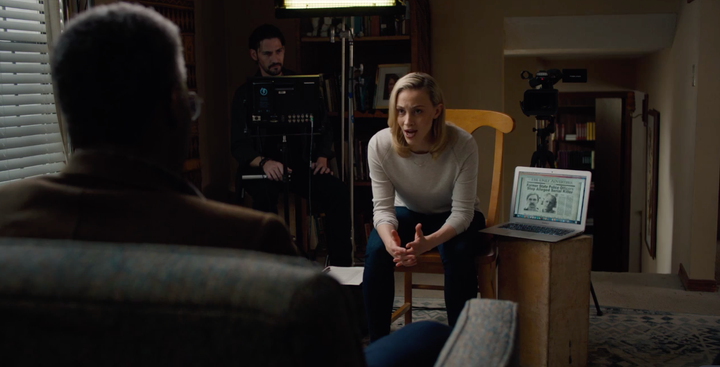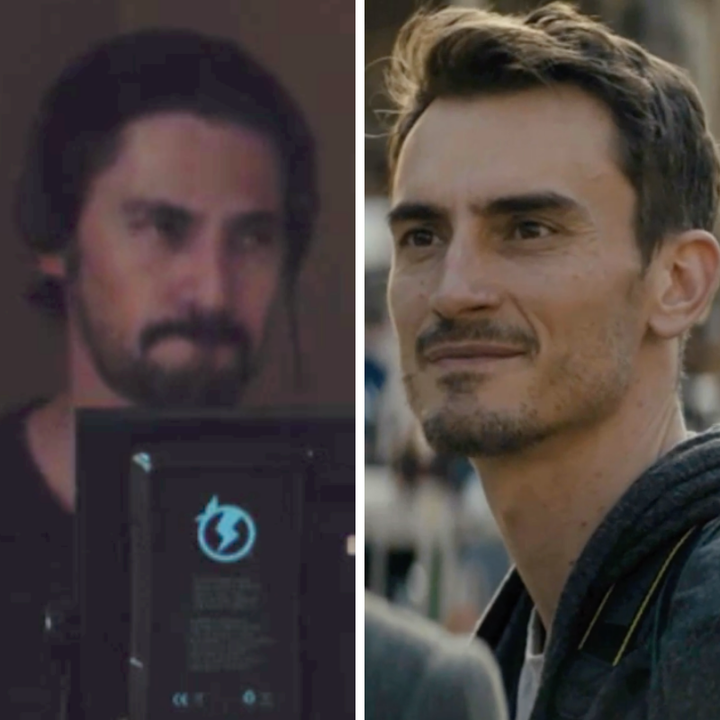At some point during the third season of the resurrected HBO show “True Detective,” I developed an itch. It’d creep up when I was watching elderly Wayne Hays (Mahershala Ali) sitting and chatting with true-crime documentarian Elisa Montgomery (Sarah Gadon), something he does quite often in the multiple timeline mystery series. My eyes fixed on the cowering former police officer and his persistent interrogator, I felt myself drawn to something else in the room. No, I wasn’t concerned with Hays’ son Henry (Ray Fisher). I kept zooming in on the unnamed script supervisor parked behind the playback monitor ― the guy you can barely see in the screenshot below.
“Who is this man?” I kept thinking every time Elisa would grill Wayne on the details of disputed missing children case. “Why is he getting so much screen time for a small role? And why does he look... familiar?”
Then creator Nic Pizzolatto threw out a curveball.

To recap, Season 3 takes place in the Ozarks and follows detectives Wayne Hays and Roland West (Stephen Dorff) as they investigate the disappearance of brother and sister Will and Julie Purcell in 1980. The detectives stumble their way through the case over the course of 35 years, finding evidence that points to the possibility of a pedophile ring fueled by elite men with power in politics and business. For longtime “True Detective” fans, this detail was intriguing. The suspected cadre of bad guys sounded familiar to the pedophile ring implicated in Season 1 by Louisiana homicide detectives Rust Cohle (Matthew McConaughey) and Marty Hart (Woody Harrelson).
In the series’ penultimate episode, “The Final Country,” Elisa outright questioned whether the missing person cases in both Season 1 and 3 are related. After asking Wayne about a possible procurer who might’ve had something to do with the Purcell kids’ disappearance, Elisa shows him images of straw dolls and spiral symbols associated with occult beliefs, then presents him with a newspaper clipping of our very own Rust and Marty.
“Dolls are used as signifiers in human trafficking underground. Like this blue spiral; it’s code for pedophiles,” she says. “In 2012, two former Louisiana state police stopped a serial killer associated with some kind of pedophile ring. Despite evidence of accomplices, the case never went wider.”
She continues:
I think what happened to the Purcell children was connected to a similar group. I think one or both of their parents sold them off, probably with the cousin’s help. That’s why they’re all gone, vanished, killed, kept silent. These groups, they take runaways, kids in orphanages, outright kidnapping. And wider investigations are consistently curtailed. In both the Louisiana and Nebraska cases, high-level politicians and businessman were implicated ― people with the power to make these things go away.
Right there, Pizzolatto confirmed Seasons 1 and 3 take place in the same universe.
So, as a devoted television P.I., trained by other HBO shows like “Westworld” and “Game of Thrones” to be on constant alert for Easter eggs and story turns, I suddenly couldn’t ignore my itch. I started scratching, as hard as only the truest of conspiracists would. My husband and I concocted a wild theory about that script supervisor: Perhaps he’s someone we already know. That’s why he’s getting so much time on camera! Then it hit us. What if, and bear with me, he’s Lenny from Season 2, the guy who died at the train station in the finale after attacking the corrupt Vinci police chief, William Holloway (Afemo Omilami). I mean, look at the resemblance:

For those who don’t remember or just skipped over the terrible, horrible, no good, very bad second season of “True Detective,” Leonard Osterman, played by actor Luke Edwards, is the mystery killer of the city manager of Vinci, Ben Caspere. By the end of Season 2, we learn Lenny ― who had about a minute of screen time over the course of eight hourlong episodes ― is the brother of Caspere’s assistant, Laura, and the vengeful son of a married couple who were robbed of diamonds and killed by double-dealing police officers during the 1992 Los Angeles riots.
Lenny, a movie set photographer, also knew about the sex parties these slimy men attended and was enraged when he found out his sister was actually Caspere’s daughter.
Keeping all of this in mind, we thought we figured it out: The script supervisor is also Luke Edwards, aka Leonard Osterman, who’s operating under an alias ― that of film crew member Lenny, who’s investigating sex trafficking rings to learn more about Caspere’s shady sex parties. Except, chronologically speaking, his turn as a documentarian takes place before his murderous debut in Season 2. Meaning Season 3′s 2015 timeline takes place first.
We’d done it! We’d cracked the code to Pizzolatto’s anthology series: Every season of “True Detective” was, we thought, in some way focused on the same crime.
Positively giddy, I reached out to Edwards’ manager, Marianne Golan, to confirm his Season 3 casting ― and that’s when everything tragically fell apart. She told me she was “99.9 percent sure” he wasn’t in Season 3 but would check with him “just in case.” A few days later, I received a crushing email:
Sorry Leigh, I did hear from Luke yesterday, and he wasn’t in Season 3 of True Detective.
Then the realization hit me: I’ve been trolled by an HBO showrunner.

You see, the moment Pizzolatto confirmed Seasons 1 and 3 take place in the same universe, I began to question everything I’d watched up to this point. Theory obsessives, like myself, began looking into key moments from every season of “True Detective,” hoping to piece together Season 1′s Yellow King storyline with Season 2′s Vinci scandal with Season 3′s Purcell case. Ahead of the finale, there is no evidence that Season 2 is mixed into the timeline ― probably because Pizzolatto wants us to forget it was ever made ― but, knowing Seasons 1 and 3 are somewhat connected changed everything for me.
The show became capital-A Anthology Television. Like Ryan Murphy’s “American Horror Story” or even Vince Gilligan’s “Breaking Bad” and “Better Call Saul” worlds. By connecting his seasons, Pizzolatto knew fans would nosedive into an investigative spiral. “Is the Yellow King responsible for the Purcell kids’ disappearance?” “Are Wayne and Rust friends?” “Is time really a flat circle?” The worlds are linked, so there must be breadcrumbs!
But, as is the case with “AHS,” the links are utterly confusing. Murphy’s swirling anthology plots provide little continuity in the grand scheme of things; there’s little reason to believe he has a roadmap in mind for every season before he co-writes them ― let alone that he knew how he’d tie them all together in the end. But it’s simply more fun to believe that he did. Just as it’s more fun, more maniacal, to believe Pizzolatto is building an empire of mystery. If “Westworld” has taught us anything, it’s that the show can be bad, but we’ll still enjoy watching it. The mystery doesn’t even need to be detectable, just let us play along. And so Pizzolatto did.
The character of Elisa seems to be his way of winking at the audience, as she, like the Redditors scrolling through thread after thread on subtopic pages, is theorizing about the true crime cases she’s studying. Like us “True Detective” fanatics, she’s investigating every detail of the Southern-set cases and coming to her own conclusions ― conclusions that may not even be near the truth.
In the end, the guise yielded story benefits for the showrunner. He got to make up for the disappointing Season 1 finale, which left us wrapped up in an emotional flurry between Rust and Marty ― a flurry that settled with a sappy speech about “light vs. dark.” Instead of getting answers to the Carcosa conundrum we examined for weeks on end, we were left wondering about nihilist Rust Cohle’s personal transformation, which, to us crime conspiracists, wasn’t the draw of the show. (Though it was excellent window dressing.)
Now Pizzolatto gets a second chance at the Yellow King conclusion, hinting at a wider crime that, well, might not even be wider?
Whether it is or isn’t, fans conditioned to tune in for tentpole HBO series to the end are buckled in and ready for the finale, which will air against this year’s plagued Oscars broadcast.
Although we’re expecting a huge tie-in to Season 1′s divinity, we’d be fooling ourselves if we think Matthew McConaughey is about to walk into the scene. Pizzolatto clearly knows better.
